Road trips are an excellent way to see scenic areas of the country you simply would not see via air travel. They are a great way for families to spend time together, a fantastic choice for couples to reconnect and have a little adventure, and a brilliant option for singles or anyone needing some quiet solo time. Depending on how lengthy and inclusive the road trip is, they are also good for travelers who cannot agree on one specific vacation destination.
Sometimes, just driving out of town and along roads we’ve never seen before can be a remarkable and eye-opening experience. Exploring the state you live in can expose you to even more. But if you’re looking for a specific route to take, one that ranks high among the favorites of most travelers, we have an alphabetical list of ten that are awe-inspiring.
Badlands and Black Hills of South Dakota
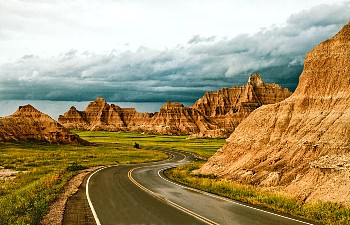 If you’re looking for a taste of the Old West, this road trip is for you! The route is crammed full of scenery and history. Travelers can visit the Crazy Horse Memorial to pay tribute to the famed Lakota warrior, celebrate America’s democracy at Mount Rushmore, and revel in the 1876 gold rush town of Deadwood, home to the legendary Wild Bill Hickok and Calamity Jane.
If you’re looking for a taste of the Old West, this road trip is for you! The route is crammed full of scenery and history. Travelers can visit the Crazy Horse Memorial to pay tribute to the famed Lakota warrior, celebrate America’s democracy at Mount Rushmore, and revel in the 1876 gold rush town of Deadwood, home to the legendary Wild Bill Hickok and Calamity Jane.
Map your route to begin on I-90 and make your way to Exit 131 for the Badlands Scenic Byway. The region gets its name from Native Americans who called it ‘mako sica’ meaning badlands, but such a label doesn’t do it justice when it comes to the scenery of majestic rock formations and native grasslands. Although this particular loop is only 39 miles long, do not expect to drive it quickly. There are 16 scenic overlooks marked on the trail, every one of them worth a look.
Have your camera charged and ready so you can quickly snap any wildlife you encounter, such as a herd of bison. Although these animals are accustomed to seeing traffic, they’re still wild and unpredictable so don’t get too close and definitely do not get out of your vehicle. You’ll find even more wildlife as you travel to Wind Cave National Park, located in the southwestern corner of South Dakota. The park is home to elk, bison, pronghorn antelopes, cougars, prairie dogs, and more. As the name suggests, the area is known for its enormous underground Wind Cave, where several walls of the cave are laden with calcite formations.
Blue Ridge Parkway, North Carolina to Virginia
 Connecting the Great Smokey Mountains National Park in North Carolina to Shenandoah National Park in Virginia is a glorious 470-mile stretch of roadway known as Blue Ridge Parkway, and it’s all about the beauty of nature. It is meant to be appreciated which is why the enforceable speed limit is set at just 45 mph and the region has banned commercial traffic and the use of billboards.
Connecting the Great Smokey Mountains National Park in North Carolina to Shenandoah National Park in Virginia is a glorious 470-mile stretch of roadway known as Blue Ridge Parkway, and it’s all about the beauty of nature. It is meant to be appreciated which is why the enforceable speed limit is set at just 45 mph and the region has banned commercial traffic and the use of billboards.
This journey through the essence of the Appalachians includes 70 overlooks along the route. Along with mountainous terrain and a color splash of wildflowers in the summer and autumn leaves in the fall, scenic views also include waterfalls and wildlife. There is a wide variety of birds in the region, including an abundance of peregrine falcons and wild turkeys. There are also fifty mammal species on record, including black bears, beavers, bobcats, coyotes, deer, and elk.
Be sure to visit Little Switzerland, a quaint little community where you can find accommodations and dining with a view. The village also hosts a general store, specialty shops for crafts and antiques, a hiking trail to Grassy Creek Falls, and the mining town of Emerald Village.
Cape Cod, Massachusetts
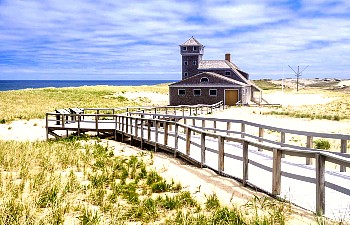
A road trip through Cape Cod is unforgettable. This 60-mile drive along Route 6a will allow you to explore adorable little towns and historical settings, such as Plymouth Rock where the pilgrims landed and hosted the first Thanksgiving. The region also includes Hyannis Port, famously known for the Kennedy Compound. The main house is where President John F Kennedy grew up and eventually used the compound as a base for his 1960 Presidential campaign.
There are seven lighthouses to see along the shoreline — Chatham, Highland, Nauset, Nobska, Race Point Light Station, The Three Sisters, and Wood End. And, of course, there are beautiful beaches and miles of unforgettable coastal scenery. Watch the water closely for whales off the coast. If you can’t see any from land, consider one of many whale-watching tours departing from Provincetown.
Depending on how much time you have to spend, consider taking the ferry from Hyannis to the infamous nearby islands of Nantucket and Martha’s Vineyard, the latter of which is known for where the classic movie Jaws was filmed.
Florida Keys Scenic Highway
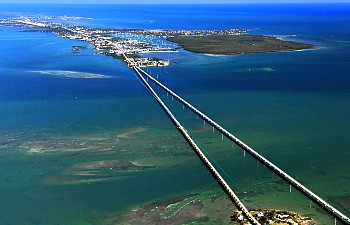 The 113-mile stretch of roadway/causeway from Key Largo to Key West is officially known as U.S. Route 1 but also carries the nickname Road to Paradise. It’s easy to see why given that the passage skims over sandbars and ocean waters as far as the eye can see. It takes travelers through charming little fishing towns, snorkeling and scuba diving hotspots, laidback resort areas, and delightful roadside attractions. The route also includes Seven Mile Bridge.
The 113-mile stretch of roadway/causeway from Key Largo to Key West is officially known as U.S. Route 1 but also carries the nickname Road to Paradise. It’s easy to see why given that the passage skims over sandbars and ocean waters as far as the eye can see. It takes travelers through charming little fishing towns, snorkeling and scuba diving hotspots, laidback resort areas, and delightful roadside attractions. The route also includes Seven Mile Bridge.
This road trip will give you an entirely different perspective of Florida. It is where the Atlantic Ocean and the Gulf of Mexico converge, so the waters take on many hues of beautiful blues and greens, and the landscape and lifestyle become far more tropical. Considering that the Bahamian island of Bimini is a mere 50 miles to the east and Cuba is only 95 miles south of Key West, it’s no wonder this region hints at a Caribbean atmosphere.
Depending on how much time you have, consider kayaking through the mangroves to see manatees and other wildlife; visit the Dolphin Research Centre on Grassy Key, or take a glass-bottom boat tour to see the reefs and marine life up close. Once you get to Key West, don’t forget to visit Ernest Hemingway’s House, Mallory Square, and the party atmosphere of Duvall Street. Take a catamaran to the Dry Tortugas, or enjoy an evening champagne cruise to witness the remarkable Key West sunset.
Olympic Peninsula Loop, Washington
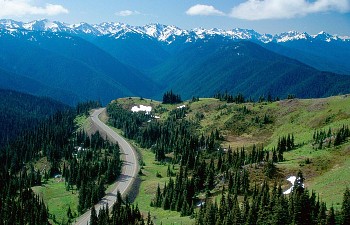 Here’s a road trip that offers a pleasant mix of scenery including mountains, forests, lakes, and the coastline. This 445-mile journey allows travelers to see the very best of the Olympic Peninsula, which is a 3,600-square-mile arm of land in the western part of Washington state that lies across Puget Sound from Seattle. The region contains Olympic National Park and several other state and national parks as well.
Here’s a road trip that offers a pleasant mix of scenery including mountains, forests, lakes, and the coastline. This 445-mile journey allows travelers to see the very best of the Olympic Peninsula, which is a 3,600-square-mile arm of land in the western part of Washington state that lies across Puget Sound from Seattle. The region contains Olympic National Park and several other state and national parks as well.
The 31-mile scenic loop that encircles Olympic National Park offers natural landscapes of tide pools, snow-capped mountains, hemlock trees, and Sitka spruce that reach 300-foot heights. Due to the mix of landscapes, watch for deer, elk, and black bears near forested areas, Olympic marmots in the meadows, mountain goats on rugged peaks, and sea stars in tide pools. Several natural lakes exist on the Olympic Peninsula, the most viewable of which on this route is Ozette Lake. Named by the native Makah, Ozette quite literally means ‘large lake’ and features crystalline clear waters and 3 islands, as well as several area hiking trails for adventurers.
Coastal views on this scenic drive include rocky cliffs, stony shorelines, and an abundance of wildlife such as eagles, peregrine falcons, and various other bird species soaring overhead, as well as sightings of gray whales and orcas off the coast.
Outer Banks, North Carolina
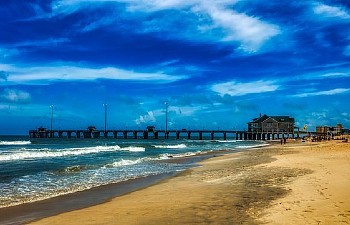 There are a few different ways to access the Outer Banks depending on how long you want your coastal road trip to be. We recommend taking a look at suggested routes from the Outer Banks tourism website HERE. You can opt for shorter drive-only routes or include ferry rides to access more of the outer islands. If you are approaching the Outer Banks from the north, you can even start as far back as Chesapeake, Virginia to experience the Chesapeake Bay Bridge Tunnel and then head south from there.
There are a few different ways to access the Outer Banks depending on how long you want your coastal road trip to be. We recommend taking a look at suggested routes from the Outer Banks tourism website HERE. You can opt for shorter drive-only routes or include ferry rides to access more of the outer islands. If you are approaching the Outer Banks from the north, you can even start as far back as Chesapeake, Virginia to experience the Chesapeake Bay Bridge Tunnel and then head south from there.
North Carolina’s Route #12 is a primary highway but also a scenic passage of 148 miles that links together the peninsulas and islands of the Outer Banks. Plus, there are two ferry systems that provide continuation of the route as it crosses the region.
This is a road trip that offers a truly memorable seashore experience of crisp salt air and miles of beach, sand dunes, and sea oats. Scenery includes fishing villages and colonial towns, as well as touristy areas and summer homes on stilts. Historic lighthouses like Bodie Island Lighthouse, Roanoke Marshes, and the famed Cape Hatteras Lighthouse can be found here. There is so very much to do in the region made up of fishing, sailing, hunting for seashells and shark teeth, museums and historical sites, and climbing Hatteras. As well, there is top-notch golf along with excellent resorts and vacation rentals. But even if you never get out of your car, it’s a trip well worth taking for the gorgeous coastal scenery and wildlife. Catch a glimpse of dolphins or hawksbill and leatherback turtles in the ocean. In rural areas, be on the lookout for bobcats, wild boars, and wild horses. And in quiet, swampy areas, watch for alligators.
Pacific Coast Highway, California
 This is one of the world’s most interesting and celebrated road trips – a coast-hugging drive along California’s Pacific Shoreline. It doesn’t matter if you start at the north or south end, you are sure to be jaw-dropped by gorgeous views. These include the Pacific Ocean and its various beaches and rocky shorelines, as well as mountainsides, and a multitude of famous stops. Because there is so much to see, it’s best not to have a specific timeline or destination in mind. Just sit back, set the speedometer to ‘cruise’, and enjoy it ALL.
This is one of the world’s most interesting and celebrated road trips – a coast-hugging drive along California’s Pacific Shoreline. It doesn’t matter if you start at the north or south end, you are sure to be jaw-dropped by gorgeous views. These include the Pacific Ocean and its various beaches and rocky shorelines, as well as mountainsides, and a multitude of famous stops. Because there is so much to see, it’s best not to have a specific timeline or destination in mind. Just sit back, set the speedometer to ‘cruise’, and enjoy it ALL.
Infamous cities and towns along the way include Big Sur, Malibu, Monterey and Carmel, Santa Barbara, and Long Beach to name just a few. And if you’re feeling truly adventurous, you might even decide to detour a bit and have a look around Los Angeles or San Francisco. As for attractions, consider the Hearst Castle, the boardwalk in Santa Cruz, the vineyards of Santa Ynez Valley, or perhaps even the Hotel del Coronado in San Diego. To get those Instagrammable photos you want, be sure to include the Muir Beach Overlook for a peek at Point Reyes Peninsula and all those scenic stairs, or the Overlook Trail and McWay Falls in Big Sur for pics of the turquoise lagoon. If you don’t mind paying a nominal fee for access, consider the Pebble Beach 17-mile drive.
Red Rock Country, Arizona
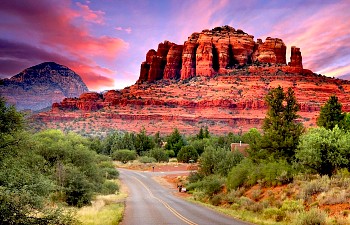 This road trip changes things up a bit, taking a break from coastal or mountainous terrains, and dropping the traveler into the midst of red sandstone cliffs and massive spires. This breathtaking landscape, located in northern Arizona, is a favorite tourist destination due in part to the magnificent panoramas but also because of the luxury resorts and spas, world-class dining, and upscale golf clubs in the town of Sedona and the surrounding area.
This road trip changes things up a bit, taking a break from coastal or mountainous terrains, and dropping the traveler into the midst of red sandstone cliffs and massive spires. This breathtaking landscape, located in northern Arizona, is a favorite tourist destination due in part to the magnificent panoramas but also because of the luxury resorts and spas, world-class dining, and upscale golf clubs in the town of Sedona and the surrounding area.
Suggested routes as per the Red Rock Country tourism site are as follows: From Phoenix, Arizona, take Interstate 17 north for about 100 miles to Arizona Highway 179. Take Arizona 179 north for about 15 miles to Sedona. From Flagstaff, Arizona, take Interstate 17 south for about 3 miles. Take Exit 337 onto Arizona Highway 89A and follow this highway south for about 25 miles to Sedona. Arizona 89A goes down Oak Creek Canyon. It is a spectacular and popular scenic drive.
With so much red rock on either side of the roadway, you might feel like you’ve landed on Mars. But with the greenery of the Coconino National Forest, along with a mix of desert vegetation, you’ll quickly realize it’s paradise on earth. March through May is the best time for viewing wildflowers in the region. As for wildlife, watch for burros and wild horses, javelina, mule deer, coyotes, and bobcats. Mountain lions also inhabit the area but tend to stay well hidden. Rattlesnakes, tarantulas, and scorpions are prominent so if you leave your car to take pictures, be careful where you step. Be sure to visit Montezuma Castle National Monument, which are well-preserved dwellings built into the cliffs by the pre-Columbian culture of the Sinagua people. Or consider Rock State Park, a 286-acre nature preserve that can provide you with a good stretch thanks to several hiking trails, a picnic area, a visitor center, and some exhibits.
Road to Hana, Hawaii
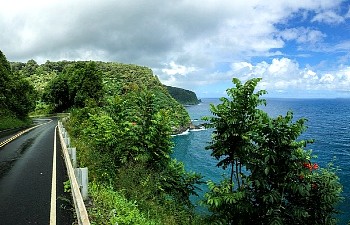
The legendary Hāna Highway traverses Maui’s northeastern coastline, connecting Kahului to the secluded beach town of Hāna. The highway is 52 miles long, contains approximately 600 turns, and incorporates 59 bridges for a journey that includes gorgeous views of the Pacific Ocean, waterfalls, black sand beaches, and some notable stops that travelers should consider making — among them, the Twin Falls Farm Stand, the Garden of Eden, Wai‘ānapanapa Wayside State Park, the Hana Cultural Centre, and Kaihalulu Red Sand Beach.
We suggest embarking on your trip early in the day to beat the inevitable traffic. Head east on the Hāna Highway (Route 36), which starts in Kahului, the location of Maui’s main airport. Around Mile Marker 16, watch for a precarious area of blind turns and one-lane bridges. Even seasoned drivers can become a little unnerved here, so just take it slow and keep your eyes on the road.
Suggestions for other areas of interest along the way include the Pipiwai Trail, which cuts through a dense bamboo forest; Seven Sacred Pools at Haleakala National Park, and Ho’okipa Beach Park for an excellent view of surfing, kite surfing, and windsurfing.
Route 66 – Crosses 8 States
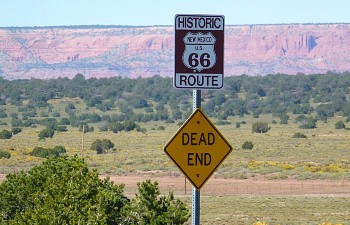 Considerably longer than any of the nine previous road trips is the 2,500-mile cross-country undertaking of Route 66. This one is iconic. There are songs, movies, and a TV show written about this infamous stretch of road that spans Chicago to Los Angeles where it ends precisely at the Santa Monica Pier.
Considerably longer than any of the nine previous road trips is the 2,500-mile cross-country undertaking of Route 66. This one is iconic. There are songs, movies, and a TV show written about this infamous stretch of road that spans Chicago to Los Angeles where it ends precisely at the Santa Monica Pier.
Most of the celebration of the route took place back in the 50s and early to mid-60s, yet despite becoming an established Interstate Highway since then, it remains to be a celebrated scenic drive that changes up the landscape often and offers the traveler a look at several unique roadside attractions. Bear in mind that there are plenty of them so this isn’t a trip you can accomplish in just a few days. To do it right and see as much as you can, you need to set aside anywhere from 2 to 3 weeks, do your research, and plan, plan, plan before you set out on your journey.
Nicknamed the Mother Road, the route spans a total of eight states, including Illinois, Missouri, Kansas, Oklahoma, Texas, New Mexico, Arizona, and California. The most well-preserved sections extend from Springfield, Missouri to Tulsa, Oklahoma; the section west of Seligman, Arizona; and the Oatman Highway that runs directly through the Black Hills of Arizona.
Just some of the special sights you can expect to see along the way include the World’s Largest Covered Wagon in Lincoln Illinois; the Historic Standard Gas Station in Odell; the Fort Blair Civil War Battleground in Baxter Springs; the Route 66 Museum in Clinton; The Blue Whale of Catoosa; The Cadillac Ranch in Amarillo; Meteor Crater in Meteor City; the Painted Desert and Petrified Forest National Park in Holbrook; the Wild Donkeys in Oatman; Cucamonga Service Station in Rancho Cucamonga, Calico Ghost Town in the Mohave Desert and, finally, the Santa Monica Pier.
Photos Credits:
Lead – Desktop Wallpaper HD.org
Cape Code – Wallpaper Safari
Outer Banks, Pacific Coast Highway, Road to Hana, Route 66 – Pixabay
Badlands, Blue Ridge Highway, Olympic Peninsula Loop, Red Rock Country – Wallpaper Cave


